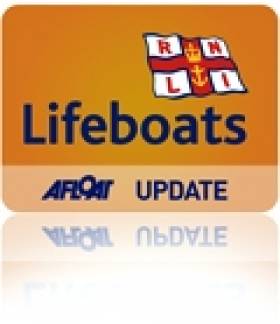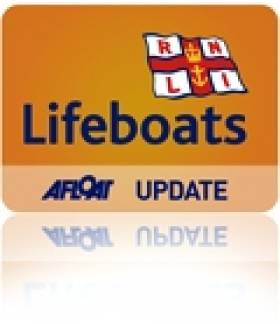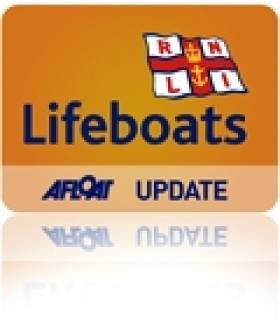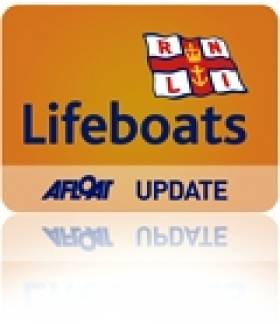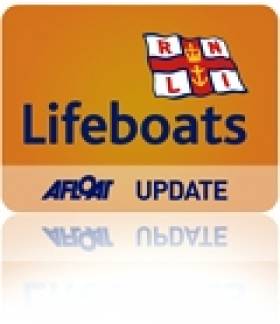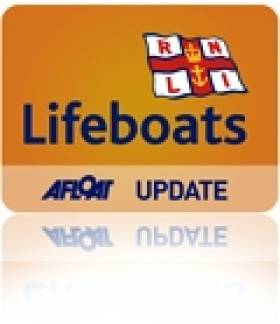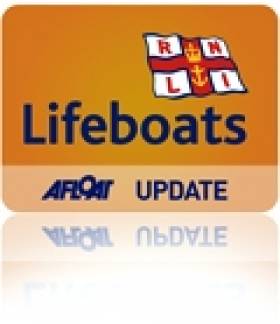Displaying items by tag: Lifeboats
Busy Times For RNLI At Courtmacsherry And Courtown
#RNLI - Courtmacsherry RNLI assisted two people after their yacht got into difficulty at the weekend.
The volunteer lifeboat crew was called out at 5.15pm on Saturday (13 July) to go to the aid of a yacht off Courtmacsherry Harbour in West Cork.
The all-weather lifeboat with a crew of six was underway within minutes and proceeded to the area where the casualty had developed mechanical failure. The lifeboat arrived on the scene in 10 minutes and proceeded to take the yacht with two people on board in tow.
Both the lifeboat and the stricken vessel were subsequently berthed at the pier in Courtmacsherry village.
This has been a busy week so far for Courtmacsherry RNLI with today's call-out being the fourth in five days.
The others were on Tuesday 9 July to an overdue jet ski in Clonakilty Bay, Thursday 11 July to the aid a windsurfer off Garrettstown, and Friday 12 July to a reported dingy off the Old Head of Kinsale which turned out to be a dead and upturned whale in the sea.
Elsewhere, Saturday was a busy evening for the Courtown lifeboat in Co Wexford.
- lifeboat was launched to a report of two vessels aground in a cove south of Courtown Harbour, quickly locating the vessels – a 15ft speedboat and a personal water craft (PWC) – just south of the harbour in the area known as Salt Rock.
There were two people with the vessels and the speedboat was grounded but swamped.
The lifeboat took both casualties, who were very cold, back to the harbour and then returned first to recover, bail out and tow the speedboat back, and then out to tow the PWC back into the harbour.
The lifeboat then returned to station and refuelled, ready for the Sea Sunday celebrations the following day.
Busy Weekend With Four Call-Outs For Portaferry RNLI
#RNLI - Portaferry RNLI in Co Down had a busy weekend with four separate call-outs over the two days.
The first came on Saturday 6 July following a report that three children were drifting offshore on an inflatable toy.
The volunteer lifeboat crew was already afloat on exercise as part of the annual raft race in Kircubbin, Co Down, when they got a call to go to the aid of the three children aged 10, 11 and 14 who were drifting out to sea on the inflatable 18 miles away at Cloughey Bay.
Thankfully by the time they arrived on scene a local coastguard unit had already attended and brought the three children to safety on shore.
Portaferry RNLI was called out for a second time at 4.10pm to rescue a number of people on board a speedboat that had lost power in Strangford Lough just off Killyleagh.
The crew arrived at the scene at 4.15pm, by which time the 15ft speedboat had already been towed in and was moored at the pontoons at Killyleagh Yacht Club in Strangford Lough.
On both occasions the weather was fine with good visibility and calm seas.
Yesterday (7 July) the volunteer crew launched for the third time to assist an injured woman on Salt Island in Strangford Lough.
The crew arrived at the island at 10.10am and assessed the situation before transporting two paramedics from Killyleagh to the injured woman, who was subsequently airlifted by Irish Coast Guard helicopter to Musgrave Park Hospital in Belfast for treatment.
At 11:35am, while returning to the lifeboat station, the crew was alerted once again, this time to go to the aid of two men onboard a five metre Dory that had lost power and was drifting just off Ringhaddy Sound in Strangford Lough.
The crew arrived on the scene at 12.05pm and took the men onboard the lifeboat, towing the powerless boat into Strangford Lough Yacht Club, where the men were then put ashore and their boat tied up.
Elsewhere in Northern Ireland, Newcastle RNLI assisted two men after their motor cruiser ran aground off the Co Down coast last Thursday (4 July).
The volunteer crew launched their inshore lifeboat at 2.20pm following a report from Belfast Coastguard that a small vessel had ran aground off Dundrum Bar with two people on board.
Weather conditions at the time were described as blowing south westerly four to five winds with moderate to choppy seas. There was good visibility.
The lifeboat, helmed by Nathan Leneghan and with crew members Declan Barry and Charles McClelland on board, arrived on scene at 2.30pm, where they observed that one of the men had made it to shore while the other was still on the 5m boat.
Speaking following the call-out, Newcastle RNLI deputy launching authority Joe McClelland said: "Thankfully, no one was in immediate danger and we were happy to bring the vessel and the man who was still on board safely to shore."
Skerries Lifeboat Rescues Colt Island Kayakers
#RNLI - Skerries RNLI rescued a group of teenagers who got into difficulty while kayaking on Sunday evening (30 June).
The volunteer crew launched their inshore lifeboat shortly after 6pm to reports of a group of kayakers on Colt Island who were unable to return to shore due to the deteriorating weather conditions.
Skerries RNLI lifeboat operations manager Niall McGrotty paged the crew after receiving information from a retired crew member that there was a group of kayakers stranded on Colt Island.
The lifeboat was helmed by Joe May and had crew members Philip Ferguson, David Knight and Adam Scott on board. Weather conditions at the time were a force five to six northerly wind and choppy seas.
Arriving on scene three minutes after launching, the lifeboat found 11 teenage boys with five kayaks sheltering on Colt Island, as they were unable to return to shore against the increasing wind and waves.
All 11 boys were taken on board the lifeboat and the five kayaks were taken in tow. The lifeboat towed the kayaks back to the slipway at the station where the volunteer shore crew recovered them. The lifeboat then brought the teenagers safely back to the harbour.
Speaking after the call-out, Skerries RNLI helm Joe May said: "The boys did the right thing in staying together, staying on the island and raising the alarm. If they had tried to make it back to shore we could have been dealing with a much more serious situation.
"Our volunteer crew are always ready to respond to any emergency and we were happy to bring everyone safely home."
Skerries RNLI Assists Lone Sailor On Grounded Yacht
#RNLI - Skerries RNLI launched shortly before 7pm yesterday evening (Thursday 27 June) to assist an 11m yacht with one person on board that had run aground north of Rush Harbour.
The Dublin branch of the Irish Coast Guard requested Skerries RNLI to launch after two members of the public, who had been out kayaking, reported that the yacht was in difficulty.
Weather conditions at the time were a force one to two wind with calm seas.
The lifeboat, helmed by Willie Boylan with crew members Conor Walsh, Karl Duff and Peter Kennedy on board, was on scene in less than 10 minutes. However, by that time the yacht was completely aground above the tide line.
Two volunteer crew members were put ashore to assess the casualty vessel. There was only one person on board and he was not in any immediate danger. There also appeared to be no significant damage to the hull of the boat.
The crew members laid out an anchor from the vessel to ensure that it did not drift onto the nearby rocks when it began to float again. Irish Coast Guard helicopter Rescue 116 was also on scene briefly to ensure that no assistance was required.
With the tide still falling, the decision was taken for the lifeboat to return later after the tide had turned to ensure that the yacht floated safely and to assist in helping it safely back to a harbour.
At 10.20pm the volunteer crew launched the lifeboat again to attend to the yacht, this time with Conor Walsh at the helm and Karl Duff, Eoin Grimes and Emma Wilson as crew, bringing a salvage pump with them.
One of the crew was put ashore to check on the casualty again and to secure a tow line to the boat. As the tide rose, the lifeboat kept the tension on the tow to prevent the yacht being pushed further on to the rocks.
At 11.45pm the yacht was refloated and guided back to Skerries Harbour with the lifeboat leading the way to help navigate around the islands safely in the dark.
Speaking after, Skerries RNLI lifeboat operations manager Niall McGrotty said: "There didn’t appear to be much damage and the conditions were calm. However, it was a large boat with a lot of equipment on board, so there were some concerns around whether it would refloat successfully. Thankfully, it did and everyone made it home safe and sound."
Donaghadee RNLI Rescues Man In Boat Breakdown
#RNLI - Donaghadee RNLI has rescued a man after his boat got into difficulty off the Co Down coast.
- In good weather conditions, the volunteer crew launched the all-weather lifeboat at 3.07pm yesterday (Wednesday 26 June) to go to the aid of a casualty off Mew Island.
It followed a request by Belfast Coastguard which had received a call from the owner of the 4m boat to say his vessel had broken down and had starter motor problems.
The lifeboat located the boat north of Mew Island, where it was taken safely under tow by the crew and brought to Donaghadee Harbour.
Earlier in the week, a group of young people from the RNLI Storm Force visited the Donaghadee lifeboat station for a guided tour that emphasised the importance of safety on the water.
The children and their parents were given a warm welcome by coxswain Phillip McNamara and members of the station, who explained the work they do when they respond to emergencies - including getting into their lifeboat gear and jackets in a hurry!
Skerries RNLI Responds To Concerns Over Shore Walkers
#RNLI - Skerries RNLI in North Co Dublin were requested to launch by the Irish Coast Guard on Monday evening (24 June) following a call from a concerned member of the public regarding a group of people walking back to shore from Shenick Island.
The volunteer lifeboat crew launched their inshore lifeboat Louis Simson shortly before 9pm and proceeded directly to scene.
The caller had reported that the group were attempting to walk ashore from the island and were already in water up to their waists. However, shortly after arriving on scene, communication was received from Skerries Coastguard that the people in question had made it safely to shore.
Before returning to base, Skerries also requested the lifeboat to check on another group of people who were on the shoreline of Colt Island. This turned out to be a group of kayakers who were simply having a rest so the lifeboat was stood down and returned to station.
Speaking afterwards, Skerries RNLI volunteer lifeboat press officer Gerry Canning said: "It’s not unusual for people to get caught out by the quickly rising tide. We would encourage people to check the tide tables and always allow plenty of time to get to where you are going safely."
In related news, an updated and interactive edition of the RNLI’s safety handbook Sea Safety: The Complete Guide is now available free online.
The Complete Guide is the RNLI’s handbook of essential information for all those who go to sea. Its new interactive format – including videos, quizzes and challenges - means that sea safety is available on mobiles, tablets and laptops and at the tip of boaters’ fingertips.
RNLI coastal safety manager Tony Wafer said: "The Complete Guide gives more in-depth advice on how to follow these principles and stay safe on the water. It’ll cover everything from how to plan your time on the water, what safety equipment to take and how to use it, and what to do in an emergency."
#RNLI - New Zealand man Greg Murphy and his wife Anne have made an emotional journey to Arklow RNLI to visit the lifeboat station where more than a century ago the lifeboat crew set out in heavy seas and torrential rain to save the life of his grandfather.
In 1897 James Murphy was just a teenager when the schooner he was on ran aground and he was saved by Arklow RNLI lifeboat crew.
The details of the call-out were recorded by then honorary secretary of the Arklow lifeboat, James Tyrell, and paint an extraordinary picture of a dramatic rescue which began at 9.45am on 28 March 1897.
James was on the schooner Express with his father, uncle and two crew en route to Wexford from Dublin when in strong winds and driving rain the vessel grounded off Arklow. The skipper was washed overboard and lost.
The Arklow lifeboat - Frances and Charlotte, a pulling and sailing lifeboat under the command of coxswain Richard Wadden - was launched and the lifeboat crew rowed through breaking seas to reach the stricken vessel.
The account goes on to detail how, on rounding the stern of the vessel, the lifeboat itself was filled by “a fearful sea” but emptied seconds later.
The hull of the schooner was under water when the lifeboat neared her and four crew members, including young James Murphy, were clinging to the rigging. In difficult conditions the lifeboat crew cast a line and secured it to the rigging with the plan to get the men to fasten themselves to the rope together and jump overboard.
However it is not known whether they did not hear or understand the instructions, but they only tied James to the rope and lowered him into the water.
He was hauled toward the lifeboat but there was not enough slack to get him onboard and the lifeboat crew shouted to the men to let him go or he would drown. They did so and the lifeboat crew recovered the boy onboard almost lifeless.
Tragically the stranded men had cast off the line and all contact with the wreck was severed. Attempts were made to again throw a line to the men but it was without success. Ultimately the mast went over into the sea, taking the men clinging to the rigging with it and they were lost. The lifeboat crew tried to recover them but were unsuccessful. It was to be the last callout for coxswain Wadden, who retired a short time later.
In subsequent months the Murphy family relocated to New Zealand. But they never forgot the story of the schooner Express and the actions of the Arklow lifeboat crew.
On visiting the lifeboat station more than 116 years later with his wife Anne and meeting with some of the present-day crew, Greg Murphy commented: “On behalf of myself and my very large family back in New Zealand, I want to say thank you for what you do.
"Without the bravery of the men of the Arklow lifeboat back in 1897 myself and my family simply would not exist. Thank you all so very much.”
Larne RNLI Assists Yacht While On Call-Out For Drifting Boat
#RNLI - While on exercise on Sunday morning (23 June 2013), Larne RNLI’s inshore lifeboat was requested to divert and investigate reports that a boat was drifting out to sea in Larne Lough.
The 11m wooden boat had nobody onboard and represented a hazard in the area.
As the volunteer lifeboat crew neared the vessel they noticed a man in a punt approaching them. The man was from a nearby boat and having become concerned at the drifting vessel, had decided to investigate and see if he could assist.
However it was discovered that his nine 9m yacht, which had another crew member onboard, had also got into difficulty and was starting to drag its mooring.
Wind conditions were force four to five with a north gusting wind and lumpy seas.
The inshore lifeboat assisted the man back onboard his vessel and a lifeboat crew member joined him. The dragging mooring was fixed and they were able to continue under their own power.
The original drifting boat was aground, and having made sure the other vessel and its two crew were safe, the lifeboat returned to assist. Establishing a tow, Larne RNLI inshore crew were able to gently pull the boat off the rocks.
They were then met by the all-weather lifeboat and the tow was passed on to them before it was safely secured on a mooring in Larne Lough and both lifeboats returned to station.
Commenting on the call-outs, Larne RNLI lifeboat operations manager Alan Dorman said: “What started as a normal Sunday morning exercise turned into a double call-out for both lifeboats.
"It shows how quickly things can change out at sea and the lifeboat is always available to assist and reassure. Thankfully on this occasion help was close at hand and no injury or damage was done.”
Larne RNLI Rescues Unconscious Man From Lough
#RNLI - Larne RNLI rescued an unconscious man who was found a short distance from the shore at Larne Lough last night (Thursday 20 June).
The volunteer crew launched their inshore lifeboat Hannahbella Ferguson following a request by Belfast Coastguard at 10.35pm to go to the assistance of a person who was spotted lying face down in the sea within 200 metres from the shore in Larne Lough.
Weather conditions at the time were good with a flat calm sea but light was fading.
The lifeboat - helmed by Willie Evans and with crew members Dave Somerville and Pamela Dorman onboard - arrived on scene at 10.41pm and pulled the casualty on to the lifeboat. With the man not breathing, two crew members proceeded to perform CPR and resuscitated the casualty.
The helm brought the lifeboat into a small slipway along the promenade which was accessible due to a high tide. The casualty was subsequently handed over to the waiting paramedics and ambulance.
Speaking after the call-out, Larne RNLI helm Willie Evans praised the crew who he said had worked together to resuscitate the casualty and bring him to shore.
#RNLI - A fishing vessel with a fouled propeller was towed to safety by Wicklow RNLI this morning (21 June).
The volunteer crew launched their all-weather lifeboat at 10am following a report that a fishing vessel was in difficulty after a rope got fouled in its propeller.
The incident had echoes of Wednesday's rescue of a couple from their similarly fouled yacht off Arklow, as reported on Afloat.ie.
Wicklow RNLI's lifeboat crew located the drifting vessel was located by the lifeboat crew some six miles off Wicklow Head shortly after 10.30am.
A towline was quickly established and the boat was towed back to Wicklow harbour where it was safely secured alongside the south quay at midday.
Another fouling incident occurred further up the coast yesterday evening, as Skerries RNLI yesterday brought two people to safety after their motorboat got into difficulty.
The volunteer crew launched their inshore lifeboat on what was their second call out of the day shortly after 7pm following a report that a 29ft motorboat was in difficulty between Rogerstown Estuary and Lambay Island.
Weather conditions at the time were calm with a force one to two wind. Arriving on scene, the lifeboat – helmed by Willie Boylan – quickly located the motorboat which had lowered its anchor to wait for help to arrive.
Once it was established that the motorboat had fouled its propeller, a crew member was put on board the boat and a towline was established. The vessel was then brought safely back to Malahide Marina.
Speaking after the call-out, Skerries RNLI crew member Conor Walsh said: "Thankfully the crew had a VHF radio on board and were able to call for help. We were happy to assist and to be able to bring them and their boat safely to shore."




























